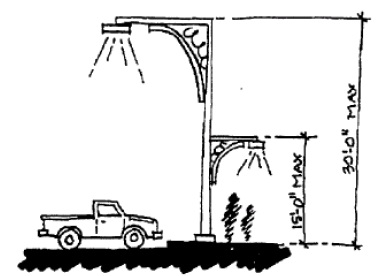(A) Applicability.
(1) Unless specifically exempt, all existing and proposed development for which site plan approval is required (see § 155.707) shall meet the provisions of this section.
(2) Buildings and structures lawfully existing as of the effective date of this chapter, may be redeveloped, renovated or repaired without modifying outdoor lighting in conformance with this section, provided there is no increase in gross floor area in such building or structure or impervious area on the site.
(3) Where a building or structure existed as of the effective date of this chapter, and such building is enlarged in gross floor area or impervious area on the site by 10% or 2,000 square feet, whichever is less, outdoor lighting as specified in this section shall be provided.
(B) Prohibited light sources. The following light fixtures and sources shall not be used within the town where the direct light emitted is visible from adjacent areas:
(1) Low-pressure sodium and mercury vapor light sources;
(2) Cobra-head-type fixtures having dished or drop lenses or refractors which house other than incandescent sources; and
(3) Searchlights and other high-intensity narrow-beam fixtures.
(C) Design requirements. Outdoor lighting shall primarily be used to provide safety while secondarily accenting key architectural elements and to emphasize landscape features. Light fixtures shall be designed as an integral design element that complements the design of the project. This may be accomplished through style, material or color. All lighting fixtures designed or placed so as to illuminate any portion of a site shall meet the following requirements:

(1) Fixture (Luminaire). The light source shall be concealed and shall not be visible from any street right-of-way or adjacent properties. In order to direct light downward and minimize the amount of light spillage into the night sky and onto adjacent properties, all lighting fixtures shall be cutoff fixtures.
(2) Fixture height. Lighting fixtures shall be a maximum of 30 feet in height within parking areas and shall be a maximum of 15 feet in height within non-vehicular pedestrian areas. All light fixtures located within 50 feet of any residential use or residential property boundary shall not exceed 15 feet in height.
(3) Light source (lamp). Only incandescent, fluorescent, metal halide, or color corrected high-pressure sodium may be used. The same light source type shall be used for the same or similar types of lighting on any one site throughout any development.
(4) Mounting. Fixtures shall be mounted in such a manner that the cone of light is contained on-site and does not cross any property line of the site.
(5) Limit lighting to periods of activity. The use of sensor technologies, timers or other means to activate lighting during times when it will be needed may be required by the Planning Board to conserve energy, provide safety and promote compatibility between different land uses.
(D) Specific lighting standards.
(1) Security lighting.
(a) Building-mounted security light fixtures such as wall packs shall not project above the fascia or roof line of the building and shall be shielded.
(b) Security fixtures shall not face a residential property.
(c) Security fixtures shall not be substituted for parking area or walkway lighting and shall be restricted to loading, storage, service and similar locations.
(2) Accent lighting. Only lighting used to accent architectural features, landscaping or art may be directed upward, provided that the fixture shall be located, aimed or shielded to minimize light spill into the night sky.
(3) Canopy area lighting. All development that incorporates a canopy area over fuel sales, automated teller machines or similar installations shall use a recessed lens cover flush with the bottom surface of the canopy that provides a cutoff or shielded light distribution.
(4) Entrances and exits in nonresidential and multi-family development. All entrances and exits to buildings used for nonresidential purposes and open to the general public, along with all entrances and exits in multifamily residential buildings containing more than four units, shall be adequately lighted to ensure the safety of persons and the security of the building.
(5) Commercial parking area lighting. All commercial parking areas shall be required to provide lighting during nighttime hours of operation.
(E) Excessive illumination.
(1) Lighting within any lot that unnecessarily illuminates and substantially interferes
with the use or enjoyment of any other property shall be prohibited. Lighting unnecessarily illuminates another lot if it exceeds the requirements of this section.
(2) Lighting shall not be oriented so as to direct glare or excessive illumination onto streets in a manner that may distract or interfere with the vision of drivers.
(Ord. 2005-11-02, passed 11-21-05)